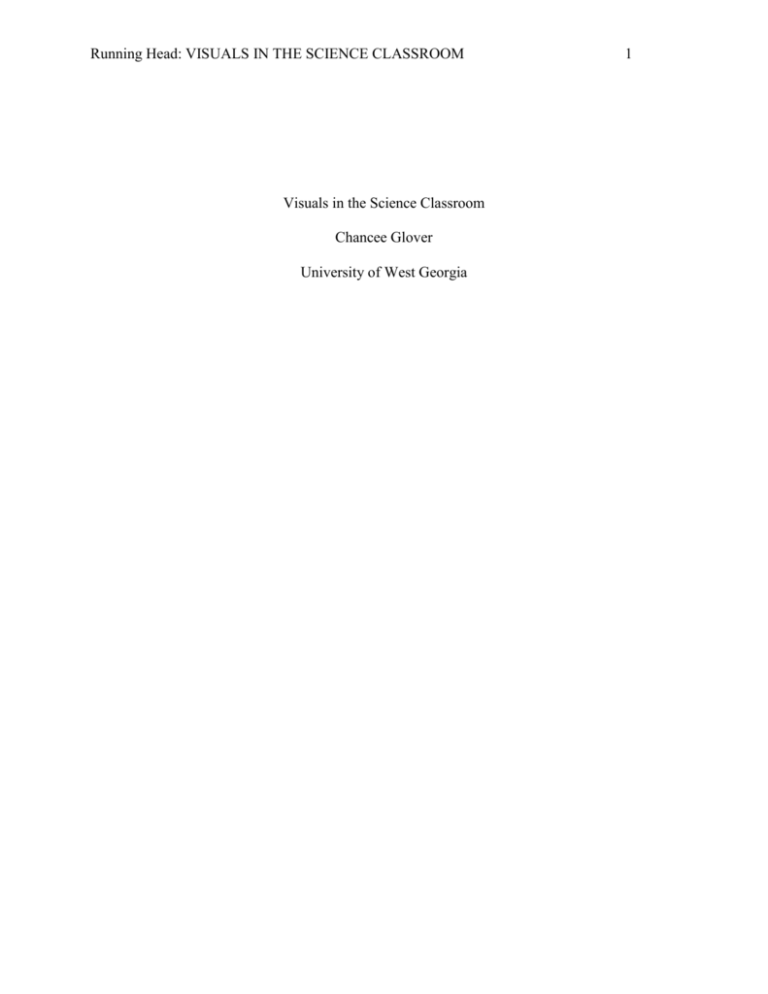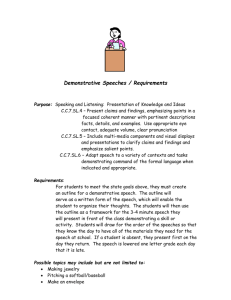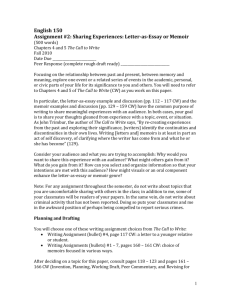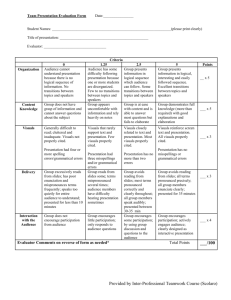Visuals in the Science Classroom
advertisement

Running Head: VISUALS IN THE SCIENCE CLASSROOM Visuals in the Science Classroom Chancee Glover University of West Georgia 1 VISUALS IN THE SCIENCE CLASSROOM 2 Visuals in the Science Classroom Study 1 "Teachers' Use of Visual Representations in the Science Classroom" by Michelle Cook offers a comprehensive case study of seven high school science teachers that use visual representations to teach complex science concepts to students. Charts, maps, diagrams, and graphs are common tools that science teachers use in the classroom to enhance learning for students. However, students should not only use these visuals as references, but teachers should add visuals in their instructional delivery in a variety of ways to create a cognitive connection between science concepts and visuals that represent them. Schools that have access to updated technology where visual tools can be readily used in the classroom have a great advantage when it comes to using visuals to teach science concepts. Having the appropriate resources available for teachers to use visuals and students to see and respond to visuals is extremely important in the impact of such instructional strategies in the science classroom. In this particular case study seven teachers were observed that used different types of visuals in teaching content material in four different science courses (Earth science, physics, biology, and chemistry). Not only were the teachers observed by researchers on multiple occasions, students were also interviewed to determine their thoughts on the use of visuals to help them better understand and retain the content. Photos, diagrams, graphs, symbolic representations, and various illustrations were used in each class when teaching different complex science concepts, all relating very easily to the daily lives of students. Many of the students that were interviewed liked the incorporation of visuals to particularly target the visual learner, which fits the overall learning style of many students. All of the teachers "recognize the VISUALS IN THE SCIENCE CLASSROOM 3 importance of resources for using visual representations" (Cook, 2011, p. 183). Without appropriate resources visuals could not be used in an effective and meaningful way. Researchers conducted a case study with the seven secondary science teachers and their students in various science content areas. A high school in the southeastern United States was used to conduct the study with nearly one thousand students and the science content areas of Earth science, physics, biology, and chemistry. Quantitative data was collected and recorded the number of each type of visual used in the science classrooms. Types of visuals were compiled into categories based on similarities in presentation methods. Qualitative data was also collected through interviews with teachers on the importance of the use of visuals in the science classroom and interviews conducted with students who were receiving various types of visual instruction. The results suggested that teachers use six considerations when selecting appropriate and relevant visuals to use for instruction: course content, type of visual, realism, learning styles, prior knowledge, and ability level. Simply using visuals in the science classroom is too vague. Teachers have to consider where students are, what they have already learned, what interests them, and how they can learn best when using visuals to represent science concepts. Diagrams and graphs were used more frequently in physics and biology when compared to the other science studied because these types of visuals related more closely to the content being learned. However, in Earth science photographs could be used because of the presence of these concepts in nature and illustrations on a molecular level were more useful in the chemistry classroom. The type of visual the teacher used was chosen based on several factors. I think that this research study was conducted very well, but I do think that the results are based on very narrow observations. There was only one school researched in the study, and this particular school did have access to various resources to be able to effectively incorporate visuals VISUALS IN THE SCIENCE CLASSROOM 4 in the science classroom. It would have been interesting to see how other schools in the region use visuals and if they based their instructional visuals on the same considerations as this school. I also think that collecting more data from student experience with learning from visuals would have complimented the study. However, I did learn that using visuals to explain complex science concepts are helpful in various areas. These visuals not only apply to the visual learners in the classroom, but they also give every student an image or illustration to associate a concept with. If students can recall the visual used then they are going to be able to relate the content to it more easily. Study 2 The second article that I analyzed is titled, "Virtual Labs in the Online Biology Course: Student Perceptions of Effectiveness and Usability" by Tracey A. Stuckey-Mickell and Bridget D. Stuckey-Danner. This study focused on the student opinions of the use of virtual labs in a biology course and whether virtual labs or face-to-face labs were more effective. The presence of collaboration and feedback for both types of labs was also considered in the study. The virtual labs and simulations tested in this study applied to students through both visual and auditory learning methods. Students were actively engaged, and these virtual labs did not mirror lecture style learning environments. The researchers express the importance of virtual labs that are actively engaging for students. Virtual learning environments can be more challenging than traditional ones in terms of engagement and active learning. Researchers outline the importance of conducting studies on the engagement of such programs to be sure that the technology being used is enhancing instruction and not just replacing traditional lectures. Virtual labs can be helpful when needed materials and funds are not available to conduct such experiences in a face-to-face environment. VISUALS IN THE SCIENCE CLASSROOM 5 The overall goal for the research was to determine the effectiveness of online biology labs by focusing mainly on student perceptions and learning experiences as compared to face-to-face labs. The study conducted was both quantitative and qualitative in that the data that was collected through online surveys taken by students where percentages were collected based on student responses and open-ended opinions were expressed. The surveys included items where students were required to rate their virtual lab experiences and items where students could provide a response to open-ended discussion questions about their perceptions and opinions of the virtual labs they participated in. The study involved "38 students enrolled in two online introductory biology courses at a Midwestern, urban, community college" (Stuckey-Mickell & Stuckey-Danner, 2007, p. 107). Students who participated in the study were ethnically diverse, none of which were biology majors. Twelve lab experiences were conducted in face-to-face sessions with the professor, and ten lab experiences were assigned to students on CD-ROMs. Face-to-face labs were hands on working with lab partners, and virtual labs were interactive where students were required to select samples to complete various tests and respond to discussion questions throughout. Surveys were given to students to complete throughout the course on face-to-face labs and virtual labs so data could be compared. Results portrayed that students found face-to-face labs more effective than virtual labs. However, sixty percent of students agreed or strongly agreed that course content was learned through the use of virtual labs. Researchers indicated various reasons to help explain these results. For example, face-to-face labs were designed directly by the biology department at the college, whereas, virtual labs were generated by an outside company. Virtual labs may not have been one hundred percent aligned to the content being taught in the class where face-to-face labs VISUALS IN THE SCIENCE CLASSROOM 6 were. Students also indicated that they liked the interaction and immediate feedback in face-toface labs. If students had a question during face-to-face labs they could easily ask their lab partner or the professor and get immediate feedback and clarification. Virtual labs could not offer the same convenience since they were completed individually. However, virtual labs required students to use more higher-order thinking and reasoning skills to figure out what to do and how to respond on their own. Students did suggest that offering online discussion for virtual labs could be a very helpful tool in enhancing the virtual lab experience. I really liked that the researchers outlined potential limitations in the study conducted like the small sample size, different concepts covered, and somewhat older versions of virtual labs that were used. The researchers also offered opportunities for future research in the area of virtual labs. I think that collecting some survey results from the professors about their opinions and resources concerning virtual labs would have been very interesting to compare to the student responses. I learned that virtual labs do offer interactive experiences for students in science courses. I think this study shows that virtual labs could be improved in the areas of communication and collaboration. However, if I had students complete virtual labs at school when I am in the classroom to guide learning and answer questions then I could see the potential benefits that virtual labs could offer. Study 3 "Visualization in Science Education" by Karen L. Vavra, Vera Janjic-Watrich, Linda M. Phillips, Stephen P. Norris, and John Macnab outlines the importance of using visuals in science education. The authors begin by describing what visualizations are in general and the types of visualizations that can be used to enhance learning in the science classroom. They support the importance of using visuals in science by explaining its relationship to the dual-coding theory VISUALS IN THE SCIENCE CLASSROOM 7 and the visual imagery hypothesis. Educators in general understand the effectiveness of incorporating visuals into science education, but these researchers focus on pulling together past studies to determine which type of visuals are best to use to enhance learning in the science classroom. They began their research by collecting "studies focusing on how visual representations, diagrams, and animations have been used to communicate the essential features and functions of important scientific concepts" (Vavra, Janjoc-Watrich, Phillips, Norris, & Macnab, 2011, p. 23). They also focused on visuals in two other areas including dynamic media and visualizations and conceptual change. They also looked at how these types of visuals affected student performance. The authors then offer suggestions for best uses of visuals to enhance learning in the science classroom. They outline the importance of relevance, content aid, combinations with verbal and/or textual methods, and providing explanations when choosing and using visuals to teach science concepts. Teachers ultimately have to be conscious of what kind of visuals they are using to teach science content. Making sure that the visuals used are appropriate for the age and content are essential in the overall effectiveness of visuals in the science classroom. This study was a collection of other research studies on the use of visuals in the classroom. Each research piece analyzed was of students mainly in elementary and middle educational settings where the use of various types of visuals was present. Research in the areas of diagrams and animations, dynamic media, and visualizations and conceptual change were used and compared. Student performance indicated by each of these studies was also analyzed and taken into consideration when determining results and suggestions. Results on the use of diagrams as visuals in the science classroom concluded that students in higher-level sciences seemed to benefit more from diagrams and understanding the structure VISUALS IN THE SCIENCE CLASSROOM 8 of them. Dynamic media results supported the view that science concepts must be engaging and interesting in order to enhance student learning. Through dynamic media students are more likely to remain engaged in active learning. Results on visualizations and conceptual change indicated that visuals alone would not enhance student performance with science concepts. Complex visuals are still going to require textual and verbal explanations so students can effectively relate the visual to the concept being taught. All of these results helped the researchers make suggestions for using visuals in the science classroom. Visuals must be logical, broken down into smaller concepts, depict relationships, seek solutions, and provide pictures of data in order to effectively enhance learning in the science classroom (Vavra, JanjocWatrich, Phillips, Norris, & Macnab, 2011). I think that this study was helpful in understanding the use if visuals in science education in various areas. I like that the study was a collection of several other studies to help explain why visuals are effective and offer suggestions as to how best to incorporate visuals when teaching science concepts. Often researchers focus on the areas of math and language arts when describing the importance of visuals so I was particularly glad to see this research being conducted on the use of visual aids in science only. I do think that the researchers could have offered some details about the specific studies that were analyzed and grouped together. It would be interesting to look up some of these studies to see the similarities and differences and the actual case studies and data collected. However, I learned that visuals are important in science education, but teachers have to understand when and how to best use the different types of visuals available. Reflection VISUALS IN THE SCIENCE CLASSROOM 9 Overall, I enjoyed this assignment. I like to read about case studies that are content specific to science so that I can enhance my own teaching practices. The studies that I was able to find were extremely insightful in offering ways to use visuals to best enhance learning in the science classroom. I have even found some resources and examples that I plan to use in my own classroom as far as visuals in science education are concerned. VISUALS IN THE SCIENCE CLASSROOM 10 References Cook, M. (2011). Teachers' use of visual representations in the science classroom. Science Education International, 22(3), 175-184. Stuckey-Mickell, T. A. & Stuckey-Danner, B. D. (2007). Virtual labs in the online biology course: Student perceptions of effectiveness and usability. MERLOT Journal of Online Learning and Teaching, 3(2), 105-111. Vavra, K. L., Janjoc-Watrich, V., Phillips, L. M., Norris, S. P., & Macnab, J. (2011). Visualization in science education. ASEJ, 41(1), 22-30. VISUALS IN THE SCIENCE CLASSROOM 11




